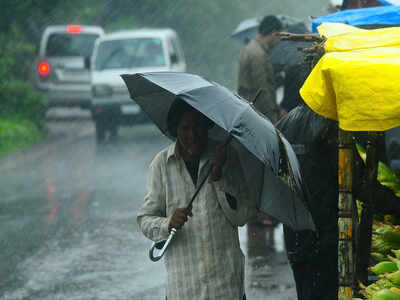
PUNE: At 873mm, Shivajinagar received its highest rainfall for June-September (monsoon) period this year since 2007, with nine days still left for September to end.
The normal rainfall for Shivajinagar for the monsoon months is 511.5mm. The location had recorded its last highest rainfall for the period in 2006 when the rain quantum crossed 1,000mm. Chronologically, the rainfall in 2019 (till September 21) for the period has been its third highest — after 2005 and 2006 — since 1992.
Pulak Guhathakurta, head, Climate Application and User Interface, Climate Research and Services, India Meteorological Department (IMD), Pune, told TOI that the normal rain for Shivajinagar for the entire monsoon period was covered by July 30 morning. “From June 1 to July 30 morning, the location received 561.8mm. From July 1 to July 30 morning, Shivajinagar received 359.8mm of rain. In June, the location had received 202.6mm of rain. Therefore, when the entire quota of June-September rainfall was covered till July-end, the rainfall during August and September added to the rain tally, causing a significant excess in the city’s rainfall this monsoon,” Guhathakurta said.
He said weather systems had aligned in a very favourable condition many times this monsoon, which resulted in excessive rainfall over parts of western and central Maharashtra, including districts of Pune, Satara and Kolhapur, among others.
Referring to a past study, Guhathakurta said out of 12 months, the month of August has proven to be very good for the state as most of the districts have shown increasing trend in August rainfall over the past 100-plus years. “In fact, for Pune district, the months of June, August and September have recorded significant increasing trend in rainfall over the past 100-plus years as per our study,” he said.
B Mukhopadhyay, former additional director general of meteorology of IMD, Pune, said, “Most systems moved in such a way this time that the rains they caused covered many parts of Maharashtra, including Pune. Low pressure systems moved according to a classic mechanism— forming over Bay of Bengal and moving across India. These systems usually give heavy rains south of their tracks. That’s what gave Maharashtra copious rains.”
Mukhopadhyay said global rain mechanisms like the Madden-Julian Oscillation — a phenomenon which, on entering the Indian Ocean, is associated with rainfall activity over India—as well as the Indian Ocean Dipole were favorable during most part of the season. “The El Nino lost its steam too gradually. All of this resulted in systems moving in a track that proved favourable to many parts of Maharashtra, including Pune,” he said.
The normal rainfall for Shivajinagar for the monsoon months is 511.5mm. The location had recorded its last highest rainfall for the period in 2006 when the rain quantum crossed 1,000mm. Chronologically, the rainfall in 2019 (till September 21) for the period has been its third highest — after 2005 and 2006 — since 1992.
Pulak Guhathakurta, head, Climate Application and User Interface, Climate Research and Services, India Meteorological Department (IMD), Pune, told TOI that the normal rain for Shivajinagar for the entire monsoon period was covered by July 30 morning. “From June 1 to July 30 morning, the location received 561.8mm. From July 1 to July 30 morning, Shivajinagar received 359.8mm of rain. In June, the location had received 202.6mm of rain. Therefore, when the entire quota of June-September rainfall was covered till July-end, the rainfall during August and September added to the rain tally, causing a significant excess in the city’s rainfall this monsoon,” Guhathakurta said.
He said weather systems had aligned in a very favourable condition many times this monsoon, which resulted in excessive rainfall over parts of western and central Maharashtra, including districts of Pune, Satara and Kolhapur, among others.
Referring to a past study, Guhathakurta said out of 12 months, the month of August has proven to be very good for the state as most of the districts have shown increasing trend in August rainfall over the past 100-plus years. “In fact, for Pune district, the months of June, August and September have recorded significant increasing trend in rainfall over the past 100-plus years as per our study,” he said.
B Mukhopadhyay, former additional director general of meteorology of IMD, Pune, said, “Most systems moved in such a way this time that the rains they caused covered many parts of Maharashtra, including Pune. Low pressure systems moved according to a classic mechanism— forming over Bay of Bengal and moving across India. These systems usually give heavy rains south of their tracks. That’s what gave Maharashtra copious rains.”
Mukhopadhyay said global rain mechanisms like the Madden-Julian Oscillation — a phenomenon which, on entering the Indian Ocean, is associated with rainfall activity over India—as well as the Indian Ocean Dipole were favorable during most part of the season. “The El Nino lost its steam too gradually. All of this resulted in systems moving in a track that proved favourable to many parts of Maharashtra, including Pune,” he said.
Get the app









